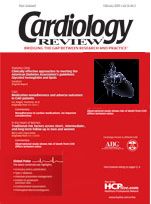Anemia and clinical outcome in heart failure
Anemia can be a powerful independent risk factor for mortality in chronic heart failure patients with both systolic and diastolic dysfunction.1-4 We studied a group of patients enrolled in the Randomized Etanercept North American Strategy to Study Antagonism of Cytokines (RENAISSANCE) trial, the details of which have been published elsewhere,5 to analyze the relationship between anemia, severity of chronic heart failure, and clinical outcome. We also evaluated the correlation between hemoglobin concentration and left ventricular mass.
Patients and methods
The RENAISSANCE trial was a double-blind multicenter study that included 912 patients with moderate to severe chronic heart failure who were randomly assigned to receive etanercept (Enbrel, a tumor necrosis factor-a antagonist) or placebo. Blood samples were taken at baseline and at 2, 4, 12, and 24 weeks. A subgroup of patients underwent magnetic resonance imaging (MRI) at the beginning of the study and at 24 weeks. For MRI studies and hemoglobin concentrations that were missing after baseline visits, a last-observation-carried-forward approach was employed. To determine whether changes from the baseline were different from 0, the Wilcoxon signed rank test was used. The Wilcoxon rank sum test was used to compare changes from baseline among groups. The log-rank test was used to perform analyses of the end points of time to death and time to death or chronic heart failure hospitalization. Continuous predictor variables were analyzed using the Cox proportional hazards regression model. P values below .05 were considered to show statistical significance.
Results
Of all patients enrolled in the RENAISSANCE study, 12% were anem-
ic (when anemia was defined as a hemoglobin concentration ≤ 12.0 g/dL). When anemia was defined as a hemoglobin concentration of 12.5 g/dL
or lower, 20% of subjects were anemic. With increased worsening of New York Heart Association (NYHA) functional class, the rate of anemia increased.
Sixty-six subjects had both he-moglobin concentrations and MRI scans taken. Over the 24 weeks of the study, when hemoglobin concentrations decreased or stayed the same, left ventricular mass index increased by a mean of 1.6 g/m2
(± 7.9 g/m2 SD; Figure 1). Left ventricular mass index decreased by 7.5 g/m2 (± 12.1 g/m2 SD), however, for subjects whose hemoglobin concentrations increased (P = .008). Based on these results, it appears that a
4.1-g/m2 reduction in left ventricular mass index occurred for every
1.0-g/dL increase in hemoglobin concentration.
Nonanemic patients (hemoglobin levels > 12.0 g/dL) had a low-er mortality rate than anemic patients (16% compared with 28%, respectively; P = .0172; log-rank test). Mortality and chronic heart failure hospitalization rates were also lower for nonanemic patients (33% compared with 56%, respectively; P < .001; log-rank test; Figure 2). A 15.8% decrease in the risk of death and a 14.2% decrease in the risk of death and chronic heart failure hospitalization occurred for every 1-g/dL increase in hemoglobin concentration. Patients with anemia had higher event rates for the two end points of death and death and chronic heart failure hospitalization irrespective of NYHA functional class (Figure 3), and mortality increased in a hemoglobin-dependent manner (Figure 4). Baseline hemoglobin concentration was an independent predictor of mortality or chronic heart failure hospitalization (hazard ratio = 0.915; P = .021), even after controlling for NYHA functional class, serum creatinine concentration, baseline diastolic blood pressure, and use of antiarrhythmic drugs and beta blocking agents. Lower mortality correlated with a higher hemoglobin concentration (Figure 4). A U-shaped association was not found. In a Kaplan-Meier analysis, 97 of the 466 subjects whose hemoglobin concentrations decreased or stayed the same died (18.1%) as compared with only 62 of 384 subjects (11.4%, P = .008; log-rank test) whose hemoglobin concentrations increased during the same period.
Discussion
The causes of anemia in patients with chronic heart failure, commonly called anemia of chronic
disease, are not clear. Low levels of erythropoietin caused by angiotensin-converting enzyme inhibitors and other drugs, the effects of cytokines, and decreased renal function are considered possible causes; low levels of hematinics, however, do not seem to be involved.6
A few studies have shown that treating anemia in chronic heart failure patients can be advantageous. Marked improvements in visual analogue score, ejection fraction, hospital events, and NYHA functional class were shown in a study in which anemia was treated with erythropoietin in chronic heart failure patients.7 Results of another study showed marked improvements in exercise duration, performance in the 6-minute walk test, peak oxygen consumption, and quality of life.8 Erythropoiesis-stimulating proteins and blood transfusions can be used to correct anemia in patients with chronic heart failure. However, none of the erythropoiesis-stimulating proteins (epoetin alfa [Epogen, Procrit]; epoetin beta; and darbepoetin alfa [Aranesp]) are indicated for anemia in chronic heart failure patients. Darbepoetin alfa can be given subcutaneously every 2 weeks or every month because of its half-life.
Conclusion
A number of placebo-controlled randomized studies are being conducted using darbepoetin alfa. Others are being planned to determine whether correction of anemia (defined as a hemoglobin concentration ≤ 12.5 g/dL) in chronic heart failure patients results in decreased morbidity and mortality and improved functional status.
